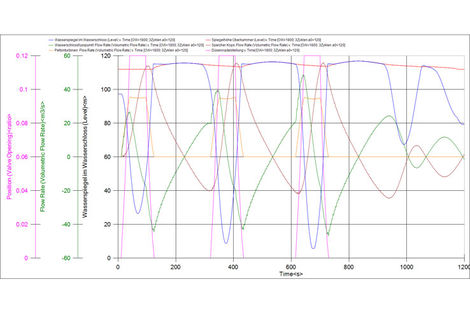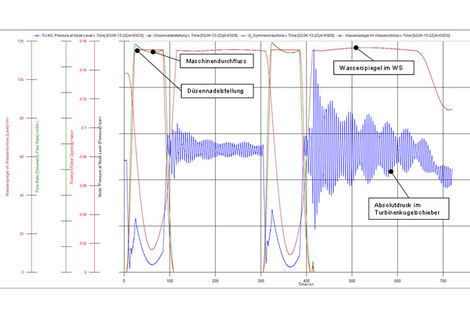Uprating of a Pelton turbine plant: feasibility study and water hammer calculation
Within the context of service works at a high head hydro power plant in the Austrian Alps the potential for a performance increase have been analysed. Such an increase is only possible by means of a further plant enlargement allowing higher flow rates whereas a feasibility study should give answers to whether the existing headwater levels were apt for such an upgrading.
The limitation of the maximum flow rate is given by the throttled two-chamber surge tank which even in case of a worst case scenario may neither overflow nor be completely drained. With the help of one-dimensional transient numerical calculations the plant can be completely modelled and the effects of an increased flow rate through the plant can be analysed.
Furthermore, the influence of the friction losses in the tunnel on the maximum surge tank oscillation amplitudes has to be examined as there are no data available for this phenomena and the information to be found is contradictory. Another task is the definition of critical load cases and operational modes of the plant which cause maximum oscillations of the surge tank and thus represent a critical situation.
As the surge tank is the principle component providing limitations to the plant and as its construction significantly influences the behaviour of the headwater level, special attention has to be put on this element. In order to be able to calculate all flow and load cases, a special software module was programmed for the asymmetrically throttled two-chamber surge tank with a lower chamber the flow streams through.
A sensibility analysis for non-documented surge tank parameters, as e.g. the filling and the emptying of the upper chamber, has been realised in order to investigate the influence of these parameters on the plant behaviour.
Results of the water hammer calculations
The water hammer analysis show that a plant performance increase of approx. 20% is possible with only minor restrictions regarding the minimum reservoir level. Furthermore it has to be said that the actual assumptions regarding the pressure losses on the waterway have to be corrected. By means of a plant measurement the simulation results were confirmed and as this measurement was effected during plant operation the extraordinary precision of the calculations results for the surge tank model could be demonstrated.
As the results of the feasibility study proved to be very satisfactory, our customer placed an order for a second test series during which the risk of water hammer for the plant configuration providing an increased performance should be investigated. For this purpose, initially the actual situation was reflected with the help of a transient simulation in order to be able to define the maximum possible plant load at that stage and to compare the result with the planning documentation and the permissible load included therein. However, the primary aim was the definition and/or optimisation of new turbine regulation laws for the redesigned plant configuration with the enhanced performance. The optimisation target was to minimise regulating time whereas the maximum plant load should stay the same or be reduced. In fact, a regulation law could be detected which provides response times shorter by up to 48(!) percent. At the same time, the new regulation laws allowed for a slight reduction of the plant load during the start-up to full load mode and the switch-off from full load mode compared to the initial situation.








